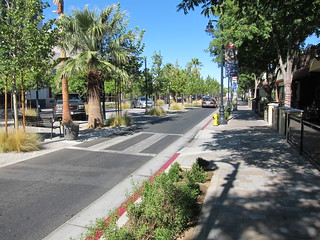 Next week, the City of Long Beach will host Pro Walk Pro Bike, a multiday conference that will bring together advocates from across the country.
Next week, the City of Long Beach will host Pro Walk Pro Bike, a multiday conference that will bring together advocates from across the country.
Resource Library

 We frequently hear about successful programs getting more youth bicycling and walking to school. But behind those programs are one or more dedicated people, often teachers that make it happen. Pat Davidson is one of them.
We frequently hear about successful programs getting more youth bicycling and walking to school. But behind those programs are one or more dedicated people, often teachers that make it happen. Pat Davidson is one of them.
En algunas comunidades, el peligro de la violencia y el crimen desanima a los niños de caminar a la escuela y la gente evita las calles, limitando sus actividades física y restringiendo sus mandados y viajes.
 In Safe Routes to School we see countless examples of elementary schools led by passionate adults and fanatical students that knock walking and bicycling out of the proverbial park – but, as a movement, I believe we struggle to connect as frequently and in meaningful ways around active transportation with both middle and high school age students.
In Safe Routes to School we see countless examples of elementary schools led by passionate adults and fanatical students that knock walking and bicycling out of the proverbial park – but, as a movement, I believe we struggle to connect as frequently and in meaningful ways around active transportation with both middle and high school age students.
WalkBoston and (MAPC) developed a tool for schools in Massachusetts to assess walking and biking potential. The tool reveals whether children living nearby are currently arriving in cars or whether most nearby students are already arriving on foot. A discussion of the tool can be found http://walkboston.org/what-we-do/initiatives/research.

 With the issuance of the new interim guidance for the new Transportation Alternatives program under MAP-21, we now know for sure that future Safe Routes to School projects no longer have the luxury of being 100 percent funded by federal transportation dollars. Now, project sponsors will need to f
With the issuance of the new interim guidance for the new Transportation Alternatives program under MAP-21, we now know for sure that future Safe Routes to School projects no longer have the luxury of being 100 percent funded by federal transportation dollars. Now, project sponsors will need to f
 We have had a lot to be thankful for recently, excepting the lasting and tragic human impact of hurricane Sandy.
We have had a lot to be thankful for recently, excepting the lasting and tragic human impact of hurricane Sandy.
 It has been a productive year for the Safe Routes Partnership in Southern California. This year, the Southern California team was off and running with a full-blown campaign at the Southern California Association of Governments (SCAG) to increase funding for active transportation in the 2012 Regional Transportation Plan and Sustainable Communities Strategy (RTP/SCS).
It has been a productive year for the Safe Routes Partnership in Southern California. This year, the Southern California team was off and running with a full-blown campaign at the Southern California Association of Governments (SCAG) to increase funding for active transportation in the 2012 Regional Transportation Plan and Sustainable Communities Strategy (RTP/SCS).
ChangeLab Solutions has developed two complementary guides to help policymakers, advocates, and stakeholders consider the effects of attendance-based funding.
 Moments ago I finished facilitating a webinar on regional approaches to Safe Routes to School through Metropolitan Planning Organizations (MPOS). The jargon involved even when clearly presenting on this topic would send even the most hardened Safe Routes to School practitioner running in the other direction. Yet, this is the point.
Moments ago I finished facilitating a webinar on regional approaches to Safe Routes to School through Metropolitan Planning Organizations (MPOS). The jargon involved even when clearly presenting on this topic would send even the most hardened Safe Routes to School practitioner running in the other direction. Yet, this is the point.
 In the past, community churches have typically served as places of worship. These institutions have been sustained by providing valuable contributions to communities in the areas of direct economic contributions, social services and community volunteering and education. This highlights the expanded role of the church from the church with
In the past, community churches have typically served as places of worship. These institutions have been sustained by providing valuable contributions to communities in the areas of direct economic contributions, social services and community volunteering and education. This highlights the expanded role of the church from the church with
This document provides a full copy of the Safe, Accountable, Flexible, Efficient Transportation Equity Act. (SAFE-TEA)
This document summarizes goals and performance measures for MAP-21.
 We have all been waiting to learn how the new federal transportation bill, Moving Ahead for Progress in the 21st Century, or MAP-21, will be implemented. The new Transportation Alternatives Program (TAP) is of particular interest since it now includes Safe Routes to School and Transportation Enhancements funding.
We have all been waiting to learn how the new federal transportation bill, Moving Ahead for Progress in the 21st Century, or MAP-21, will be implemented. The new Transportation Alternatives Program (TAP) is of particular interest since it now includes Safe Routes to School and Transportation Enhancements funding.
This book provides government officials, transportation decisionmakers, planning board members, and transportation service providers with an overview of transportation planning. It contains a basic understanding of key concepts in statewide and metropolitan transportation planning, along with references for additional information.
 Leah Murphy is a currently a Master's Student at the University of California Los Angeles.
Leah Murphy is a currently a Master's Student at the University of California Los Angeles.
A comprehensive school physical activity program (CSPAP) can ensure that students achieve the recommended amounts of daily physical activity by providingopportunities for physical activity before, during and after the school day. This resource describes components of a CSPAP.

